Craft time is a fun and creative way to engage your children and expose them to new art and cultures. India is bursting at the seams with a rich and varied background, with a heritage and culture so diverse that there is no end to the possibilities of what you can replicate during art and craft time. Here are five fun and creative Indian crafts for kids to learn and enjoy.
1. Pot Painting
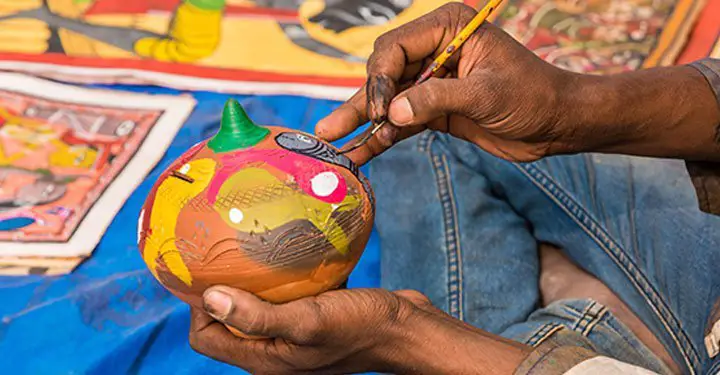 Source: By Vidya Nesarikar And Siddiqha Naseem @ Parent Circle, “5 easy Indian arts and crafts ideas for kids: Help your little ones gain an understanding of our rich culture” (https://www.parentcircle.com/easy-indian-arts-and-crafts-ideas-for-kids/article)Nothing says wholesome and traditional Indian craft than painting an earthen or clay pot under the cool shade of a big banyan tree during a sweltering hot day. What better way to get your child interested in art, painting, and crafts than spending a lazy couple of hours on a summer’s day at home painting a mud pot. You do not need all that much for this particular craft.
Source: By Vidya Nesarikar And Siddiqha Naseem @ Parent Circle, “5 easy Indian arts and crafts ideas for kids: Help your little ones gain an understanding of our rich culture” (https://www.parentcircle.com/easy-indian-arts-and-crafts-ideas-for-kids/article)Nothing says wholesome and traditional Indian craft than painting an earthen or clay pot under the cool shade of a big banyan tree during a sweltering hot day. What better way to get your child interested in art, painting, and crafts than spending a lazy couple of hours on a summer’s day at home painting a mud pot. You do not need all that much for this particular craft.
Materials
- Clay pot
- Sandpaper
- Paint, preferably acrylic paint
- A few brushes of different size
Method
The hardest thing about this craft? Figuring out what to paint. Or you and your child could go freestyle and embrace your inner Jackson Pollock. But here’s what you need to do to get started.Step 1: Wash your clay pot. Get rid of any excess dirt or mud that is caked around the edges off with a good rinse.Step 2: Once your pot is dry, grab a bit of sandpaper, scrubbing, and scraping till you smoothen the clay. Scrap away hard enough to remove any patchy, uneven or rough spots, and to even out bumps. Step 3: Your pot is ready and primed. Now all you need is to get started on your painting. Use acrylic paint to paint some pretty designs on the pot. Feel free to hit up Pinterest if you are looking for inspiration. You can use thinner, fine bristled brushes to draw on your pot and to finish up with those final bits of detail. Display your child’s work on your cabinets, or use the pot as a pencil holder.
Diya Painting
Source: By The Craftables, “DIY Diwali Diya Decoraction Ideas in 10 Mins!” (https://thecraftables.com/diy-diyas/)Alternatively, you can switch out the clay pot, for a Diya. Diwali and festive times call for a mandatory Diya-painting craft session, where your child can use the same materials used to paint the pot to paint a colorful, traditional Diya-lamp that you can, once again, find in most stores, or order online on Amazon.Once your child has finished painting and the paint dries up, you can light a little candle in there or pour some oil, dip, set up a wick, and light it up!
2. Paper Plate Rangoli
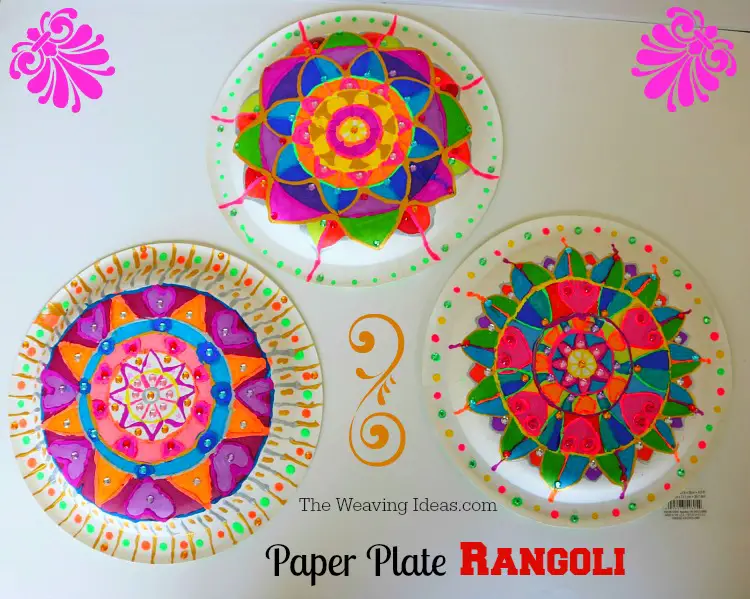 Source: Inspired by Aparna @ Weaving Ideas, “Diwali Craft: Paper Plate Rangoli Idea for Kids” (http://www.theweavingideas.com/2016/10/diwali-craft-paper-plate-rangoli-idea-for-kids/)Rangoli is such a beautiful Indian tradition. Typically, you use colored rice flowers and either draw or use patterned sieves to trace beautiful designs onto a surface, usually the front of your house where everyone can admire it during the festive season. So how do you bring that activity to your child during craft time?Rangoli”¦.painted on a paper plate?
Source: Inspired by Aparna @ Weaving Ideas, “Diwali Craft: Paper Plate Rangoli Idea for Kids” (http://www.theweavingideas.com/2016/10/diwali-craft-paper-plate-rangoli-idea-for-kids/)Rangoli is such a beautiful Indian tradition. Typically, you use colored rice flowers and either draw or use patterned sieves to trace beautiful designs onto a surface, usually the front of your house where everyone can admire it during the festive season. So how do you bring that activity to your child during craft time?Rangoli”¦.painted on a paper plate?
Materials
- Paper plate, preferably white
- Acrylic paint
- Different-sized brushes
- Pencils to draw your design on the plate or stencils, if you have them.
Method
Step 1: Use a pencil or a stencil to draw a rangoli pattern onto your plate. If you want a different colored canvas, then go ahead and paint your paper plate with a base coat first. Rangoli is pretty colorful on its own and will look amazing even on a bland background to offset the colors. So if you do paint the plate, pencil in your design carefully over the paint.Step 2: Now comes the fun part. You have prepped your plate and have your design stenciled out. Go ahead and paint swirls of color over them to form a beautiful rangoli pattern.
Alternative method
If the paint isn’t your go-to medium, you can still make rangoli art on paper plates. How? You switch out your paints for colored scraps and bits of paper, of course. Here’s how you do it.
Materials
- Paper plate
- Four or five colored craft paper
- Scissors
- Craft glue
- Pencil
Method
Step 1: Start by tracing your design on the plate with a pencil.Step 2: Help your child with this step, as it involves using a pair of scissors: cut out strips and bits of colored craft paper, to fit your design. Go wild with color, craft time is all about color. Step 3: Next, layout the colored paper over the stenciled design and make sure all the bits go where they need to. Satisfied with the layout and how the colored paper bits look? Here comes the messy – and fun – part. Step 4: Start gluing the bits of paper where they belong.
Tip:
Allow the glue to dry. You can sketch a border for your colored paper and really make your rangoli design stand out.
3. Henna or Mehendi Art
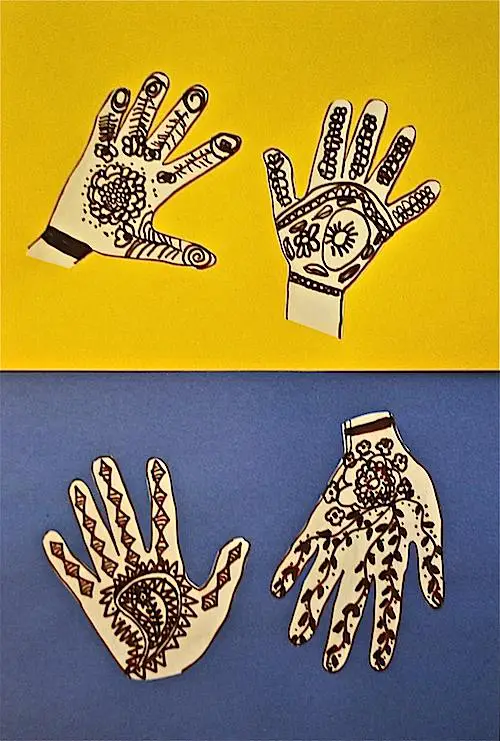 Source: By Becky @ Kid World Citizen, “‘Henna Hands:’ A Simple Craft” (https://kidworldcitizen.org/henna-hands-a-simple-craft/)
Source: By Becky @ Kid World Citizen, “‘Henna Hands:’ A Simple Craft” (https://kidworldcitizen.org/henna-hands-a-simple-craft/)
What is Henna or Mehendi?
A plant that has been used as a dye for as long as history can trace it back, henna–or Mehendi (Mehandi or Mehndi) as it is called in India– brings to you a smell that is so earthy, heady and natural, so reminiscent of the days when the leaves of the henna tree were plucked, washed and then ground into a paste, right at home.Sometimes, you”˜d eat the leaves, although not directly – they are extremely bitter. But Mehendi leaves are used as a key ingredient in many ayurvedic medicines. Mehendi is also used to make a kind of hair pack and then applied to the hair as a sort of dye, one that stains a bright crimson hue. But for the purpose of craft time, let’s keep the Mehendi away from our hair unless you want to end up a redhead. Here are a couple of craft ideas that involve Mehendi.
Materials
- Pencil
- Paper, preferably thick. Consider using chart paper.
- A stick of Mehendi or just a black pen or marker.
Method
Step 1: The first step is to trace your hand onto a paper. On a flat workspace, place your left hand – or your non-dominant hand – on the paper and then lay your palm flat on it. Make sure your hands are spread far enough apart. This will help you get easy access with your pencil.Step 2: Carefully trace out an outline of your palm, making sure to be extra careful when you get to the spaces between your fingers where it curves. You can either trace just your palm or trace a certain distance up your arm to get the desired length. Step 3: Now comes the part where you get to draw your Mehendi design on the hand you stenciled. There are two ways you can do this.
Method 1
The first would be to pencil your design on the paper, and once you’re satisfied with how it turned out, ink it with a pen or marker. This particular method gives you a lot of room to make mistakes, to change your mind about the design. It gives you even greater room to make your design colorful: you can color in your Mehendi design, or stick to monochrome.
Method 2
This method involves actually using the henna or Mehendi to design your paper hand after you pencil in your design on the paper. You can and will find a stick or tube of Mehendi in pretty much any convenience store across India, or you can order it off Amazon. Either way, it should not be too difficult to find if you live in India.What can be difficult is getting the henna stains off surfaces, cloth, and most often, you can expect the henna to stain your fingers. So, if you are up to get a little messy to get the full and authentic experience of Mehendi art and craft, of smelling the fragrance of the Mehendi as you bend over to draw on your hand, then you’re in for a treat. Just make sure to lay plenty of newspapers around to control the craft-zone, and also to allow your Mehendi to dry completely when you’re done. Using thicker paper will ensure that the Mehendi doesn’t soak through.
Bonus Method 3
If you are brave enough, you can forgo the paper hand altogether and tattoo pretty designs on your own hands. Adult supervision is definitely advised. Mehendi tattoos are temporary. The lovely tradition of applying Mehendi to a bride’s hands goes a long way back.You can start with a small design, which you allow to dry for a couple of hours and then scrape off with a ruler, or just wash off. Overnight, the Mehendi design will darken into a lush, deep red. Pinterest has some beautiful designs, patterns, motifs, and step-by-step instructions for beginners and experts alike to choose from. Mandala or Madhubani Mehendi art is a great and unique way to not just learn how to use Mehendi, but an even greater way to introduce children to a new art form.
4. Block Print Craft
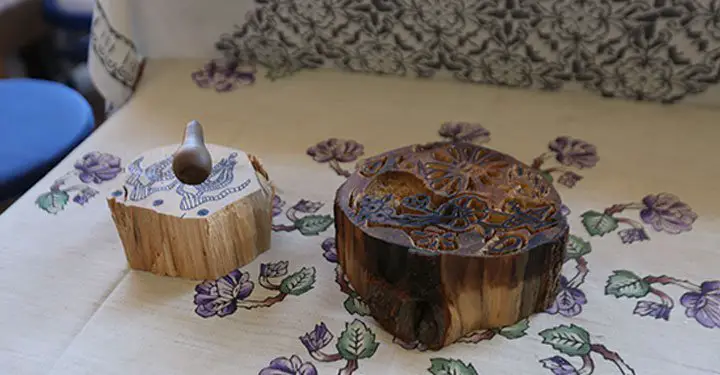 Source: By Vidya Nesarikar And Siddiqha Naseem @ Parent Circle, “5 easy Indian arts and crafts ideas for kids: Help your little ones gain an understanding of our rich culture” (https://www.parentcircle.com/easy-indian-arts-and-crafts-ideas-for-kids/article)The textile industry in India is exquisite, with its unique prints, patterns, and weaves. Ikkat, Kalamkari, Bandhani, Ajrak. Bagh, Batik, and Patola are just a few in a long list of prints that India is known for. A great way to introduce children to the heritage that the textile industry of India has in store is block print crafts. There is no short supply of carved wooden or rubber blocks and stamps that act as a stencil to etch a beautiful pattern onto a canvas, be it paper, or fabric. You can find them at local fairs, craft stores or order them online, at a reasonable price. These wooden blocks capture little bits of the traditional prints in their grooves, their carved curves and nooks. Or, if you really want to get creative, read on ahead to find out how to block print…without a block!
Source: By Vidya Nesarikar And Siddiqha Naseem @ Parent Circle, “5 easy Indian arts and crafts ideas for kids: Help your little ones gain an understanding of our rich culture” (https://www.parentcircle.com/easy-indian-arts-and-crafts-ideas-for-kids/article)The textile industry in India is exquisite, with its unique prints, patterns, and weaves. Ikkat, Kalamkari, Bandhani, Ajrak. Bagh, Batik, and Patola are just a few in a long list of prints that India is known for. A great way to introduce children to the heritage that the textile industry of India has in store is block print crafts. There is no short supply of carved wooden or rubber blocks and stamps that act as a stencil to etch a beautiful pattern onto a canvas, be it paper, or fabric. You can find them at local fairs, craft stores or order them online, at a reasonable price. These wooden blocks capture little bits of the traditional prints in their grooves, their carved curves and nooks. Or, if you really want to get creative, read on ahead to find out how to block print…without a block!
I. Block Print Craft with Fabric
Materials
- The print block, wooden or rubber.
- A small piece of fabric.
- Fabric paint (alternatively, you can even use a stamp pad if you want to mix it up).
- A flat, wide paintbrush
Method
Step 1: The first step is to decide what color you want to paint with. Once that’s fixed, grab your paintbrush and use it to apply the paint onto the block. Make sure you cover all parts of the design on the block evenly. Step 2: Layout the piece of fabric on a flat surface. Step 3: With the design part of the block facing downwards, press the block down on the fabric, applying adequate and firm pressure. Hold for around five seconds and carefully pull the block away and enjoy the lovely print on the fabric.
II. Block Print Craft on Paper
Materials
- Print Block
- Acrylic paint or ink from an inkpad
- A flat, wide brush
- Paper
Method
Step 1: Using the same method we read about earlier, use the brush to paint over the print carving on the block. You can paint more than one color on the block to get a lovely and colorful finish.Step 2: With the design end of the block facing downward, once again press the block down firmly on the paper. Hold it in place for a few seconds before gently pulling the block stamp away.
III. Bonus Method
I promised a creative way to block print without actually using a block print or stamp and I plan to deliver just that. How? By using a vegetable instead of a wooden or rubber block! But what vegetable? How do you get the print design on the vegetable? Do you use paint or dye? Here’s all you need to know.
Materials
- Vegetable or fruit of choice: potato or zucchini, or apple or pear, if you plan to do some of your own carvings. Alternatively, you can use vegetables like okra, the leaves of greens like bok choy, spinach, lettuce, and cauliflowers.
- Paper or Fabric
- Poster or acrylic paint for Paper
- Fabric paint or vegetable dye for fabric
- Chopping board
- Knife
Remember that adult supervision is non-negotiable when using a knife to carve out patterns and designs on the vegetables.
Method
Step 1: Find an adult to cut, clean, and carve out designs on the vegetable or fruit of choice. Potatoes, pears, apples, and zucchini are super absorbent and will provide a pliable surface area to practice carving. You can find inspiration on the internet and even a step-by-step- tutorial or two on how to carve designs.Once your vegetable or fruit carving is complete, pat it dry.Step 2: Using the paintbrush, apply the paint, dye or ink depending on whether you use paper or fabric. Alternatively, you can pour a little paint onto a paper plate or tray and dip the vegetable in it. Press the vegetable into an inkpad if using one. Step 3: After you shake off any excess paint, with the design facing downward, press the veggie onto the paper or fabric, holding it in place firmly before removing it to check on the print.
Tip:
Make sure you cover the surface that you lay the fabric or paper on with newspaper, to prevent the paint, ink or dye from staining it during the printing process.
5. Paper Lantern Craft
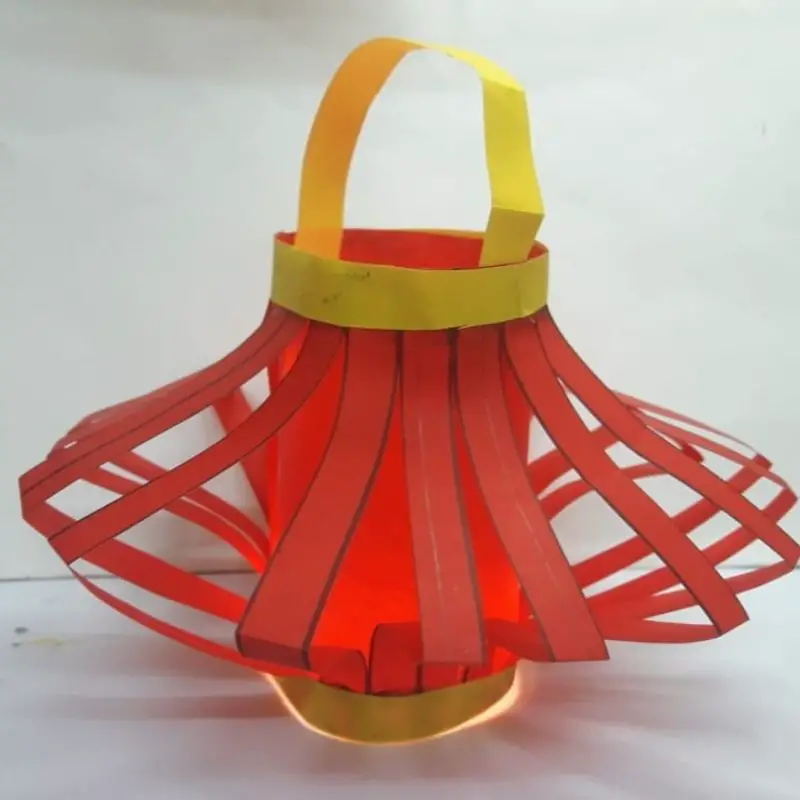 Source: Inspired by Dr Archana Yeolekar @ School My Kids, “DIY Paper Lantern for Diwali ““ Easy Décor Ideas for Kids” (https://www.schoolmykids.com/activities/diy-paper-lantern-for-diwali)Color and light are prerequisites for any Indian craft session and a classic and decorative paper lantern is a wonderful craft to learn. No matter where you go in India, you will find colorful and attractive paper lanterns hanging off the porch of a house, or in a line, attached to a string and used as decorations to light up the streets during a festival. How do you incorporate all that light, color, fun and make it into a beautiful craft? Paper lantern craft session!
Source: Inspired by Dr Archana Yeolekar @ School My Kids, “DIY Paper Lantern for Diwali ““ Easy Décor Ideas for Kids” (https://www.schoolmykids.com/activities/diy-paper-lantern-for-diwali)Color and light are prerequisites for any Indian craft session and a classic and decorative paper lantern is a wonderful craft to learn. No matter where you go in India, you will find colorful and attractive paper lanterns hanging off the porch of a house, or in a line, attached to a string and used as decorations to light up the streets during a festival. How do you incorporate all that light, color, fun and make it into a beautiful craft? Paper lantern craft session!
Materials
- Colorful sheets of craft paper
- Scissors
- Stapler or tape
- Pencil
- Ruler
- Glue
- Decorative trinkets and materials: stickers, ribbons, sequins, gift wrap, washi tape, buttons and beads.
Method
Step 1: Pick out the colored craft paper you want to use. Start out with A4 size or even just a rectangular sheet of paper. Step 2: With the help of an adult, cut out an inch wide strip off the short side of the paper. This will later be used as the handle, so let’s just set it aside for now.Step 3: Fold the paper in half lengthwise and then, using a ruler and a pencil, first mark another inch wide strip along the length of the paper and draw a line across. This line is just a guide, an indicator for when you start cutting.Step 4: Starting from the bottom of the paper, cut a straight line up, about an inch in width, up the paper, all the way up till you reach the horizontal line you initially drew. This is the first strip. Continue to cut strips along the length of the paper, till you reach the horizontal end. Step 5: Unfold the paper, and you will notice the several vertical slits that run up and over the middle where you folded the paper in half.Step 6: Now comes the fun part: decorating your lantern! You can paint the edges, draw pretty borders, or use washi tape to border them. You can glue sequins, beads and buttons. You can cut out small flowers and stick them strategically across the body. Don’t forget to decorate the handle as well.Just have a ball decorating your beautiful lantern. Step 7: Once you’re done decorating, bring the edges of the top and bottom of the sheet, and for a tube shape. Make sure you overlap the long edges at least half an inch or so. Step 8: Staple or tape the overlapping ends together securely. Step 9: Remember the handle you decorated earlier? Glue the ends on the inside of the lantern’s top side. Let the glue dry and your beautiful Indian lantern is all done and ready for you to hang!
Comments
0 comments


